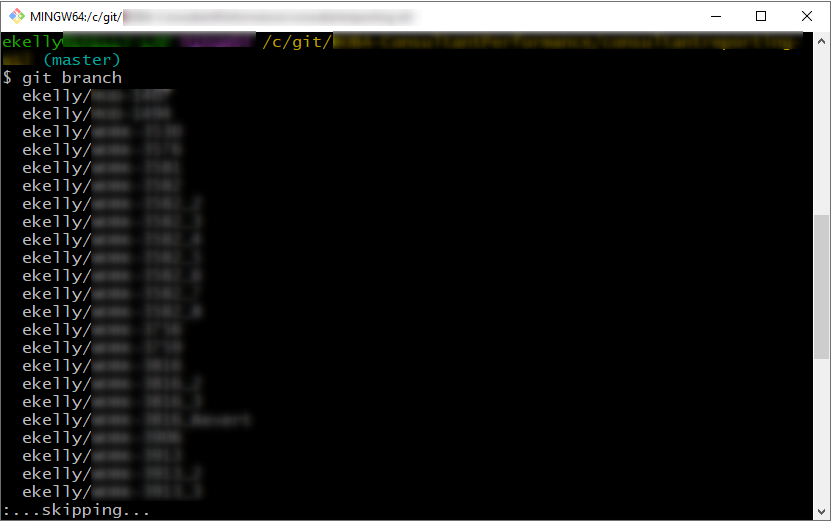
If you use Git Bash or another form of Git on your local development machine for version control in your organization, have you ever looked at how many branches you have from old work? Sometimes I forget that Git is keeping every single branch I’ve ever made off of master in the past unless I manually go in and delete it. This means I end up with an insane number of local branches hanging out on my computer, some of them months old. It’s not necessarily bad that these local branches are still around, but I know that I will never need them again after the related ticket or software change has been deployed to Live. Any pertinent information that might be needed for reference for that branch is stored in our remote repo which means I don’t need it hanging around on my machine.
When I finally remember to check how many local branches I have on a repo (using the command “git branch”), I am shocked to see dozens upon dozens of branches like in the above screenshot (which is only about half of the old branches I have on that repo). Then I want to get rid of them but also don’t want to use “git branch -D <branch>” for every single individual branch to clean them up one by one since that would take me quite a while to complete.
The faster way to get rid of all local branches, taught me by a coworker, is the following: “git branch | grep -v “master” | xargs git branch -D”. Note: use this with caution because it will delete everything and you don’t want to delete something that you still need. Also, there are some caveats with which this command won’t work, and you can read more about that on StackOverflow.
TL;DR: the above command will fetch the list of all branches available on the current directory/repo, will get all branches except the one you specify with “grep -v” (so that you can keep the local master branch), and will then delete all of those branches with a force delete.
Let’s break down each part of that command:
- “Git branch”
- This is the command that will list all local branches on the current repository
- Using a pipe character (the vertical bar “|”) will tell the command to feed in the results of what’s on the left of the pipe into the command on the right of the pipe, which in this case means we are feeding the list of local branches into the command “grep -v “master””
- “grep -v “master””
- The grep command will print output matching a specified pattern
- The option “-v” signifies that the inverse of the list matching a pattern should be output
- In this scenario, the two above points mean that this full command is going to take the list of all local branches and print out all of them that aren’t the specified branch, which in this case is “master”. If your main branch isn’t called master, you can change that value to whatever branch you don’t want to delete with this command.
- “xargs git branch -D”
- I haven’t been able to definitively figure out what the xargs command is doing (if anyone has documentation on this, please send it my way!), but essentially it seems to be taking the list of branches created with the two previous commands and running that list through the normal “git branch -D” command which will perform a hard delete on those branches.
- “git branch -D” is the command used to force a delete of a branch (the -D is short for using the two options “–delete –force”)
This isn’t the most necessary Git command you’ll ever use in your work, but it does come in handy to keep your work organized and decluttered if you’re someone like me who values that.
